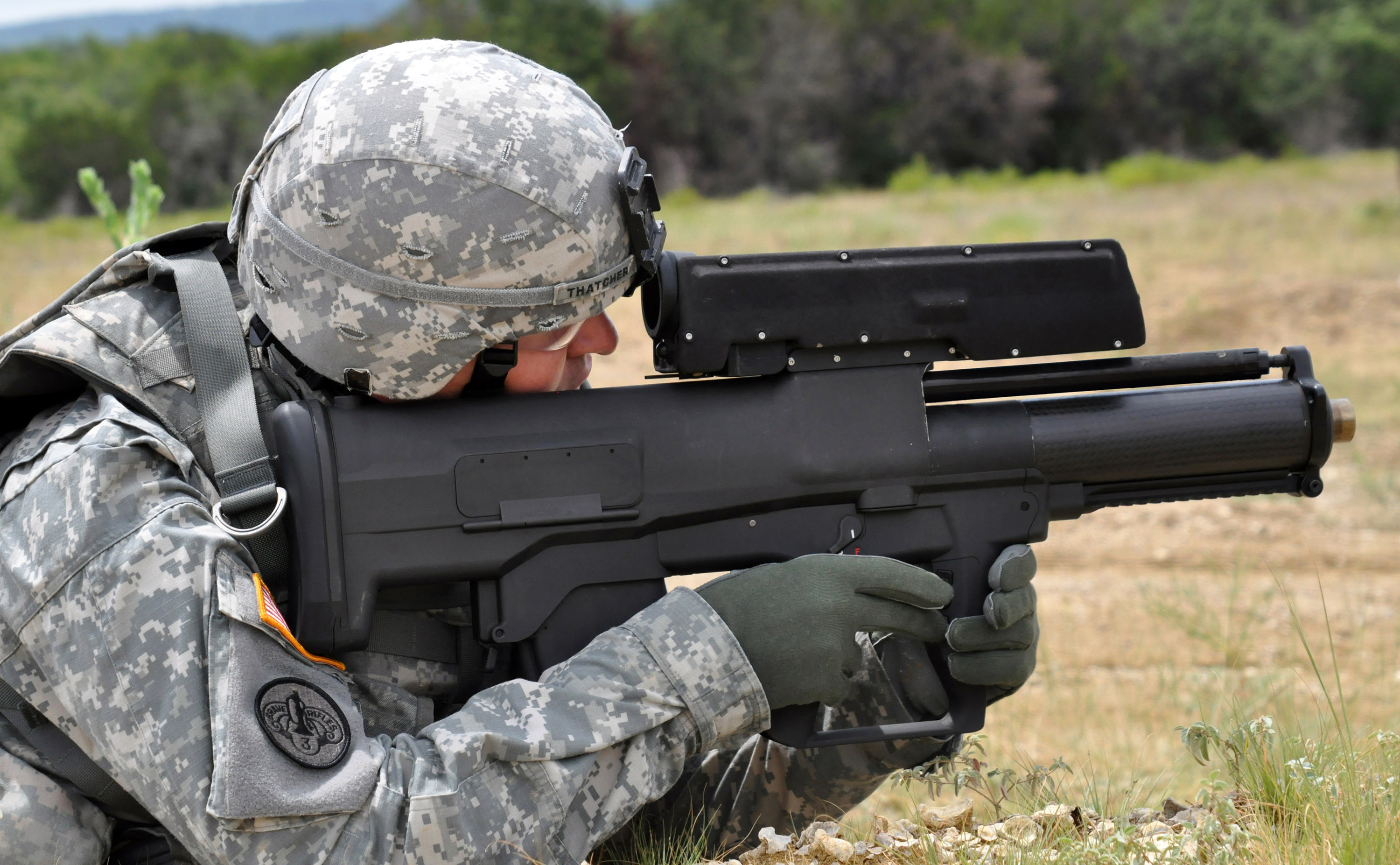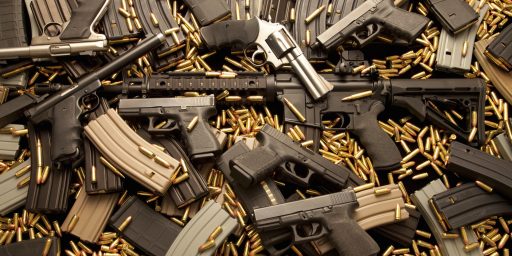Next-Generation Assault Rifle to ‘Pack a Punch Like a Tank’
Will the NRA lobby to have these on America's streets?
The National Interest has an interesting post from Jared Keller of Task & Purpose (“The Army Says Its New Assault Rifle Will Pack a Punch Like a Tank’s Main Gun“)
The Army claims its new assault rifle will unleash a hailstorm of specially-designed shells with as much chamber pressure as a battle tank to tear through even the most advanced body armor — and if all goes according to plan, the soldiers will get them to play with sooner than they thought.
The service plans on fielding a Next Generation Squad Automatic Rifle (NGSAR) — the first version in the Army’s Next-Generation Weapons System that chambers a round between 6.5mm and 6.8mm — as a potential replacement for its 80,000 M249 SAWs starting in fiscal 2022 rather than the original target date of fiscal 2025, Col. Geoffrey A. Norman, force development division chief at Army HQ, told Task & Purpose, with two per nine-man infantry squad.
While the service still hasn’t set official requirements for the system, the NGSAR will weigh less, shoot farther, and pack more punch than the service’s existing infantry weapons, Norman told Task & Purpose. And more importantly, the platform will incorporate a chamber pressure superior to the current system in soldiers’ arsenals to ensure that the rounds can still blast through enhanced enemy body armor at up to 600 meters.
The goal, as Norman put it, is to equip infantry soldiers with an automatic rifle “that fires a small bullet at the pressure equivalent to what a tank would fire.”
“The chamber pressure for the standard assault rifle is around 45 KSI [kilopound per square inch], but we’re looking for between 60 and 80 KSI … the chamber pressure when an M1 Abrams tank fires is on that order,” Gordon told Task & Purpose. “We’re looking to reach out around 600 meters and have lethal effects even if the target is protected by body armor.”
My initial reaction, given the repeated use of “assault rifle,” was that, whatever one thinks of the wisdom of having AR-15’s and AK-47’s in the hands of private citizens, we surely would want to draw the line at weapons that can “reach out around 600 meters and have lethal effects even if the target is protected by body armor.” But even the current-generation SAW has long since been officially re-designated as the M249 light machine gun (although the old acronym clearly stuck). As the name suggests, it’s an automatic fire weapon, not a semi-auto like the variants of the AR-15 and AK-47 easily available to civilians.
Indeed, while the SAW and M-16 are “assault rifles” (or, in the case of the SAW, and “assault weapon”) in military parlance, weapons without the ability to switch into automatic mode (or, in the case of later generation M-16s, burst mode) are not. But the fact that they look the same has all but eliminated the distinction in the public discourse—enough so that it confused me, even though I have military training in my distant past.
Then again, I’m sure the NRA would be happy to have these on the streets.





With the current regulations, I think that a semi-automatic version of these guns would probably be street legal (unless there is something about the ammo type). It’s an unfortunate example of how our laws, not to mention our governmental structures, are not particular good at keeping up with technological advancements.
Barring no major changes at the federal level, just as with armed personal drones, this is going to be decided at the state level. And the results will be the typical patchwork of gun laws (most likely resulting with these being legal in certain states and not in others).
Surely you’ve read the 2nd Amendment, James? A nuclear missile fulfills the plain language of the word ‘arms’, and if I can manage to lug it around or even support it in some way I’ve fit the definition of the word ‘bear’.
So F you, commie.
This HAS to be one of the most pointless articles I’ve seen on this site.
Is the NGSAR capable of firing more than one round per trigger pull? Then it’s already illegal to sell to civilians.
Would the manufacturer make a civilian-legal version of the NGSAR? Almost certainly. There are plenty of reasons why civilians might want such a thing.
1) Veterans who want a personal weapon that they are already very familiar with.
2) People who think military-style weapons are “cool.”
3) People who just HAVE to have the newest thing that has the newest technology.
And let’s cut through the stupid scare tactics. There is not a single thing about this gun that existing guns can’t do better.
For example, the Barrett M82 rifle. It fires a huge bullet (.50 caliber), has an effective range of about half a mile, and hits with enough power that pretty much any hit is a kill. If you have about $7,000 to drop, and you have a clean record (like the Florida shooter did, thanks to the Broward County Sheriff’s Department), you can get one.
Of course, you get a rifle that’s almost five feet long, weighs over 30 pounds, and has enough recoil to knock a lot of people on their butts, but boy howdy does it make big booms and big holes.
But the fact that they look the same has all but eliminated the distinction in the public discourse—enough so that it confused me, even though I have military training in my distant past.
Because the best way to deal with gross ignorance in political discourse is to simply cater to it.
Is there any other category besides guns where ignorance of the subject is actually celebrated, and actual expertise is considered the same as a bias?
Let’s see “automatic” so banned from civilian ownership since it wasn’t owned by a civilian in 1986.
Short barreled rifle so even in a semi-automatic version would require a FFL to own
Special, and obviously expensive ammo designed to penetrate armor – Well, the FN five-seven has ammo designed to penetrate body armor. As a consequence, non-military, non-goverment individuals are restricted to only the “sporting” (hollow point) ammo. All other ammo varieties are strictly illegal for civilian possession.
So unless they make a non-armor penetrating ammo for a semi-automatic variant with a longer barrel this isn’t something that is allowed for non-governmental ownership under current laws and precedents.
And let me establish my “gun credentials” here: despite my gun-related nom de plume (a legacy of my wargaming youth), I have touched and fired exactly one gun in my life, and that was during the Carter administration. And yes, I could legally own a gun if I so chose; I don’t because I’m “pro-choice” on gun ownership, and I choose not to.
And I still apparently know more about guns than a whole lot of people here.
The design of armor piercing rounds depend son the armor they intend to pierce.
The first guns, known more as hand-canons, were far different from what we think of as guns. Plain iron armor could stop early bullets. Armorers in fact fired a bullet at a completed chest piece, which dented it, to mark it as bullet-proof. Or so the lore claims.
In time, advances like grain powder, longer muzzles and stronger steel which could take higher pressures, made bullets impossible to stop by iron and steel armor.
A higher-velocity round, even if not designed to pierce body armor, could pierce it, or cause more severe damage to the person wearing it. Already Kevlar armor is insufficient to stop some rounds from high-power rifles. That’s why ceramic plates have been added to the body armor worn by troops.
So it’s not a matter of whether the new rifle type is automatic or not, nor of muzzle length, but rather of breech pressure that can hurl the round at higher, more lethal speeds containing much more kinetic energy.
If the AR-15 has no place among civilians, well, this new weapon shouldn’t even be considered for that market.
About nukes, you don’t need the whole missile, just the warhead. That can be lugged around easily in a pickup truck (for tactical nukes), or a moving van (for strategic ones). In the 50s-60s the US military had man-portable tactical nukes. At that time, it seemed a tactical nuke was the answer to every tactical problem. Can’t get close enough to bomb a Soviet ship? A 5 kiloton warhead on an air-to-surface missile will take care of it and most of its escorts, and you don’t even have to score a direct hit. Too many Soviet tanks pouring in? Man-portable sub-kiloton shoulder-launched missiles for all.
@Bob The Arqubusier:
Climate change.
Economics.
Comparative religion.
Shall I go on?
@Mike Schilling: Well, Google says: “Did you mean: Arquebusier”.
@Bob The Arqubusier: @JKB: While not explicitly stated, I thought it obvious that the point of the post is that, despite the misleading way “assault rifle” is used in the public/media debate over guns, submachine guns like this are more-or-less banned under current law. My closing comment was just to point out that the NRA opposes that policy.
@Bob The Arqubusier:
The functioning of government.
By that defintion, a bolt action .308 deer rifle qualifies as an assault weapon.
@James Joyner:
A submachinegun is a fully automatic weapon that uses pistol caliber ammunition (e.g. the stereotypical 1920’s tommy gun, which used .45ACP rounds).
@Bob The Arqubusier: Yes, it’s well known you spend huge chunks of your life researching and regurgitating statistics on a subject you care little or nothing about. Many people would consider this a pathetic waste of time, but many people actually have worthwhile things to do.
@wr: It’s called “curiosity.” It’s often considered a sign of intelligence, which explains why you’re unfamiliar with it.
Stick to personal attacks. It’s what you’re best at. Admittedly, you’re really bad at that too, but you’re less bad at that than when you try to contribute to the discussion.
@Stormy Dragon: You know the difference between a submachine gun and an assault rifle? You’re obviously some psycho gun nut who is compensating for some inadequacy or something. You should let gun policy be set by people who barely know which end goes boom, and are damned proud of how little they know.
@Mike Schilling: Climate change.
Economics.
Comparative religion.
Actually, in those areas the people you’re presumably denigrating aren’t “proud of their ignorance,” we’re just knowledgeable enough to ask pointed questions and have a good idea when the self-styled “experts” are full of crap.
@Kathy: I love it when a woman talks nerdy.
Apologies, but your comment really got me thinking about the mechanics of this new gun, and how that might translate into a civilian version.
As everyone (except, possibly wr) knows, force equals mass times velocity. So to increase the force of a bullet, one must increase its mass, velocity, or both.
This new caliber is larger than the current standard US/NATO round (5.56mm), so that covers the “mass” part. But it’s smaller than the Soviet/Russian standard (7.62 mm), so that doesn’t take care of the complete shortcoming.
It sounds like they’ve also increased the velocity by designing the gun to withstand greater chamber pressure. But chamber pressure isn’t a product of gun design, but the ammunition. The gun is simply capable of withstanding higher chamber pressures that are generated by the ammunition.
So another key element is the ammunition. For the round to generate greater chamber pressure, the primer must be more powerful. And this also has two ways of achieving its goal: a new, more powerful propellant, or more propellant. (Or, of course, both.)
Which means that we have another cost factor for the gun: the ammunition. We’re talking about a new, unique caliber AND a change in the propellant (either in volume, composition, or both). To further complicate the cost angle, this new ammunition will not be compatible with the vast majority of existing gun designs, which are not built to handle the increased power of the round.
(Here’s another bit of random speculation: I wonder about the “chicken or egg” aspect of this weapons system. Was the gun designed to withstand the more powerful round first, or did the designers come up with the round, then design the gun to handle the new round?)
Traditionally, another way of increasing a gun’s power is by lengthening the barrel. Once the primer goes off, the bullet immediately accelerates, and continues to accelerate as long as it’s within the barrel, as the gases keep expanding as long as it is contained by the barrel and the bullet. And this has the additional benefit of increasing the accuracy of the round, as the bullet is imparted stabilizing spin by the rifling of the barrel, and the longer the barrel is, the more spin is imparted. (For an example of this taken to an almost ridiculour extreme, see the “punt gun.”)
The tradeoff here is that the longer the barrel is, the heavier and more cumbersome the gun is. And this new gun is specifically cited to have a short barrel, so while they’ve found a way to “cheat” on its power, they are probably still stuck on a slight loss in accuracy — but the weapon is considerably lighter and more “user-friendly.”
So, what does all this mean for a civilian version of the NGSAR? It means that, in addition to the higher cost of the gun (all that R&D has to be amortized), the ammunition itself will be more expensive. Not only will it be using a new, unique caliber, but it will be using a special propellant package that will mean that other guns can’t use unless they, too, are designed to handle its power.
So here’s my barely-above-worthless guess: the civilian version of the NGSAR will look like the military version, but it will be chambered for more common calibers, and will skimp on the “increased chamber pressure” reinforcing the military versions.
So, basically, it will be an NGSAR “shell” around an entirely conventional rifle. As far as the owner is concerned, it will be the same as the military version (assembled, disassembled, and maintained pretty much the same way, meaning that veterans trained in its use will be very familiar to them), and accessories for one version will work with the other, but in actual use it will be no different than many other guns on the market. Much like how, functionally, there is almost no difference between an AR-15 and the Ruger Mini-14 Ranch Rifle.
But it will look scary, so the gun-grabbers will promptly wet themselves and demand that it be banned.
Thanks, Kathy, for giving me the excuse for this little mental exercise.
@Kathy: One more thought: the comparison to the power of the NGSAR to an Abrams tank is essentially marketing hype.
As I started out by noting above, force equals mass times velocity. The NGSAR’s round is 6.5 to 6.8 millimeters in diameter and weighs grams; the Abrams’ round is 120 millimeters in diameter, and its weight is measured in kilograms. So the force they carry is different by many, many orders of magnitude.
“As everyone (except, possibly wr) knows, force equals mass times velocity.”
This is priceless. Absolutely sure yet absolutely wrong. As a high-school student with two weeks of physics could tell you, force equals mass times acceleration.
@Bob The Arqubusier:
Force equal mas times acceleration, F=ma. Kinetic energy equals half the mass times the square of the velocity, Ke=1/2mv^2.
@Francis: @Kathy: Damn, high school really was a long, long time ago.
Yes, I mixed up “force” with “kinetic energy.” Thank you both for catching and correcting me.
And while I did switch the two terms, the rest of my comments are accurate: the way to increase the power of a firearm is to make the bullet faster, heavier, or both.